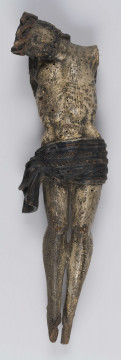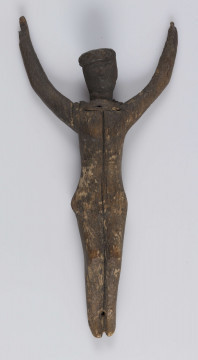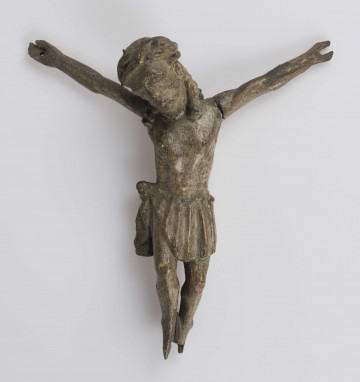
Christ Crucified
1801 — 1900
National Museum in Lublin
Part of the collection: Folk Art of the Lublin Region (17th–1st half of the 20th c.)
In folk art, an important place is given to Christ, who through his earthly life became closer to man than God the Father sitting on the heavenly throne. That is why people prayed to the Son of God and Mary, believing in their holy intercession and protection. Their images, together with those of their patron saints, were placed in wayside shrines or on crosses, as evidenced by the variety of preserved sculptures. Marian representations were more often connected with miraculous figures in sanctuaries, while Christological ones, modelled on church art, with the last stage of life – passion, death and resurrection. The most popular among the latter are: Sorrowful Christ, Crucified Christ and Risen Christ. Each of the depictions had a set manner of presentation, and sculptors tried to follow it. The Nazarene depicted Jesus awaiting Pilate's sentence, in a standing position with his hands bound with a thick cord. The Sorrowful, referring to the last scene of the road to Golgotha and being a symbolic summary of the Passion, presented the Son of God sitting on a stone or rock, with his head supported on one or both hands and often with the skull of Adam on his knee or under his foot. The iconographic pattern of the Crucified, established in the 13th century, depicted Christ wearing a crown of thorns, with his head placed on the joint of the cross beams and leaning towards the right shoulder, covered only with a hip band (perizonium), nailed to the cross: with his hands spread out nailed to the horizontal beam and his feet crossed or not and nailed with one or two nails to the vertical beam. A later image of the Risen Christ – formed during the Gothic period – presented Christ in a standing position, with his chest bare and wounds visible, covered with a cloak and wearing a royal crown, blessing with one hand and holding a triumphal banner on a cross-ended pole with the other. Although the form of sculptural representations was determined by the canon established for centuries, each artist had his own vision of the work. It was manifested in the way the crown of thorns was shaped from chain links or thorny bush twigs, the folds of robes – perisonium or mantle – and locks of hair and beard, but it was most visible in the expression of the face and the tightening of chest muscles indicating the immensity of suffering.
Author / creator
Dimensions
cały obiekt: height: 57 cm
Object type
cross
Technique
painting technique
Material
clay, paint
Creation time / dating
Creation / finding place
Owner
The National Museum in Lublin
Identification number
Location / status

1801 — 1900
National Museum in Lublin

1801 — 1900
National Museum in Lublin

1801 — 1900
National Museum in Lublin
DISCOVER this TOPIC
Museum of King Jan III's Palace at Wilanów
DISCOVER this PATH
Educational path